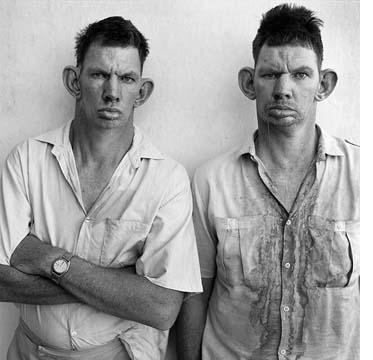Roger Ballen at Fahey/Klein Gallery
Roger Ballen is a photographer so identified with a black-and-white aesthetic of despair that similar work is referred to as “Ballenesque.” His in-your-face portraits of people living on the margins of society, in economic deprivation and psychological anguish, became the motifs and mythology of his lens.
These images are staged—set up with the collaboration of his subjects, in chaotic settings with clutter and debris reorganized to fill the square format of his camera. For anyone unfamiliar with this work, which has evolved over a period of 40 years, it can come as a shock. In his new book, Ballenesque: Roger Ballen, a Retrospective, he digs into the scope and origins of his career, in the process revealing the natural evolution of the pictures that would evolve from documentary-style to completely fictional.

In the book he writes, “I think what is probably most defined in southern Africa, where I have made my home, is the dichotomy between the First and the Third Worlds. I’m originally from the First World, and live like a First World person. But in just five steps, I’m in the Third World. I like to bring that concept to mind because the unconscious, the id, is like the Third World; the First World is like the ego. For me, living in South Africa is like my relationship between my ego and my id. I’m constantly going back and forth between them, and so the environment is similar to my state of mind.”
Working as a geologist, Ballen settled in South Africa where he traveled by car through vast expanses of uninhabited bush country. A photographer since his school years in New York City, he continued photographing on his long car trips in the early 1980s, wondering what to shoot and when he would develop his own style.
He says, “I remember very clearly in a dorp called Hopetown, Cape Province, where the famous Hope Diamond was found, knocking on a door, as I had decided that day that I could no longer wait for people to find me, or for the softer light of the evening. I asked the man who answered if I could enter his house. At that epochal moment, I went inside – literally and metaphorically. It was then that I found the motifs I would work with for the remainder of my career, began using a flash for the first time, and discoveredthe ‘character types’ that dominate my imagery from that point on. It was against this background that…I encountered my subjects and photographed them. I was drawn to those houses where chaos and disorder prevailed. I found myself among people living on the margins in a world bordering on the edge of the mind.”

Ballenesque: Roger Balleln, a Retrospective (Thames & Hudoon 2017 Info) is available at a solo exhibition of images from the book at Fahey/Klein Gallery, with an opening reception on Saturday, April 28, from 2 to 4 pm. 148 North La Brea, between 1st Street and Beverly Boulevard in Los Angeles,CA Info
All images are © copyright Roger Ballen from the book Ballenesque –Roger Ballen: A Retrospective published by Thames & Hudson and the accompanying exhibition on view at Fahey/Klein Gallery, Los Angeles from April 26 to June 15, 2018. CV19.BOOK.PHOTO


